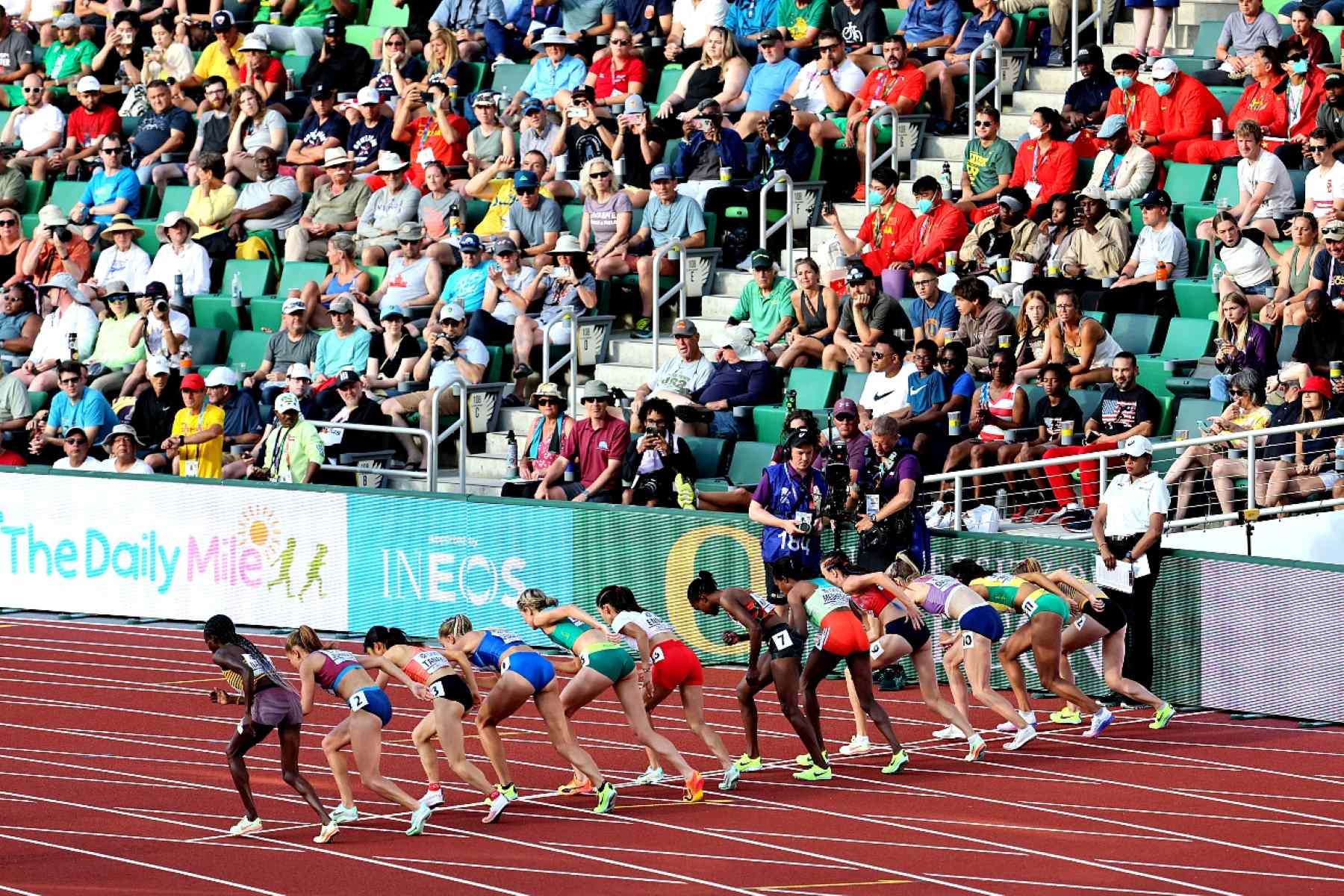Home>Misc>Featured>How Does Blood Doping Enhance Athletic Performance


Featured
How Does Blood Doping Enhance Athletic Performance
Modified: August 19, 2023
Discover how blood doping, a controversial technique, enhances athletic performance. Gain insights into the featured methods and risks involved.
Introduction
Athletic performance has always been a subject of fascination and exploration. Athletes are constantly seeking new ways to gain a competitive edge and push the boundaries of human capability. One controversial method that has emerged in recent years is blood doping, a practice that involves manipulating the blood’s oxygen-carrying capacity to enhance performance.
Blood doping is not a new phenomenon. It has been around for decades and has been used in various sports, ranging from cycling to long-distance running and even in professional team sports. The concept behind blood doping is simple: by increasing the number of red blood cells or by boosting the oxygen-carrying capacity of the existing cells, athletes can enhance their endurance, stamina, and overall performance.
While blood doping carries its fair share of risks and ethical concerns, its allure lies in the potential for significant performance gains. By artificially increasing the body’s ability to deliver oxygen to the muscles, athletes can delay the onset of fatigue, push through physical limits, and ultimately achieve better results.
There are different methods of blood doping, each with its own set of advantages and risks. One common method involves the re-infusion of an athlete’s own blood, typically taken months in advance, to increase the red blood cell count. Another method involves the use of erythropoietin (EPO), a hormone that stimulates the production of red blood cells.
However, it’s crucial to acknowledge the potential dangers associated with blood doping. The risks of excessive blood thickening, increased blood pressure, and the potential for heart problems cannot be overlooked. Furthermore, the use of banned substances like EPO can lead to severe health consequences and legal repercussions for athletes.
In recent years, sports organizations and anti-doping agencies have implemented stringent measures to detect and discourage blood doping. These measures include blood testing, conducting unannounced tests, and imposing severe penalties on athletes found guilty of doping.
This article will delve into the various aspects of blood doping, including its history, methods used, effects on performance, mechanisms of action, risks and side effects, and the measures taken for detection and prevention. By understanding the intricacies of blood doping, we can shed light on the challenges faced by the world of sports and the need for a fair and level playing field.
What is Blood Doping?
Blood doping is a technique used to enhance an athlete’s performance by increasing the number of red blood cells or the oxygen-carrying capacity of the blood. The idea behind blood doping is to optimize the body’s ability to deliver oxygen to the muscles, ultimately improving endurance and stamina.
Red blood cells play a crucial role in transporting oxygen from the lungs to the body’s tissues. By increasing the number of red blood cells or boosting their oxygen-carrying capacity, athletes can increase their aerobic capacity and delay the onset of fatigue.
There are several methods used in blood doping, each with its own advantages and risks. One common method is autologous blood doping, where an athlete’s own blood is withdrawn and stored before being re-infused back into the body. This is typically done several weeks or months in advance to allow the body to replenish its red blood cell count.
Another method of blood doping involves the use of erythropoietin (EPO), a hormone naturally produced by the kidneys that stimulates the production of red blood cells. EPO can be synthesized artificially and administered to athletes to increase their red blood cell count rapidly.
Another approach to blood doping involves the use of blood substitutes, such as perfluorocarbons, which can carry and deliver oxygen to the tissues without the need for increased red blood cells. While these substances are not currently used in mainstream sports, they have been explored in medical and military scenarios.
It’s important to note that blood doping is considered unethical and is banned by sports organizations and anti-doping agencies. The use of blood doping gives athletes an unfair advantage over their competitors and undermines the spirit of fair play in sports.
Despite the risks and ethical concerns, blood doping remains a tempting practice for some athletes. The allure of improved performance, increased endurance, and the potential to achieve remarkable feats can sometimes override the moral and legal implications.
In the following sections, we will explore the history of blood doping in sports, the effects it has on athletic performance, the mechanisms of action behind blood doping, the risks and side effects associated with the practice, and the detection and anti-doping measures in place to deter athletes from engaging in blood doping.
History of Blood Doping in Sports
The practice of blood doping in sports dates back several decades. It first gained attention in the 1960s when endurance athletes started exploring ways to enhance their performance through increased oxygen delivery to the muscles.
One of the earliest documented cases of blood doping involved a Danish cyclist named Knud Enemark Jensen, who died during the 1960 Rome Olympics. It was later discovered that he had taken a combination of amphetamines and nicotinyl tartrate to improve his stamina. This incident highlighted the growing desire among athletes to gain an edge through performance-enhancing substances and techniques.
In the 1970s and 1980s, blood doping became more prevalent among endurance athletes, particularly in long-distance running and cycling. Athletes started experimenting with the reinfusion of their own blood, which allowed them to boost their red blood cell count and improve their oxygen-carrying capacity.
The breakthrough moment for blood doping came during the 1984 Los Angeles Olympics when the technique became widely known. The Finnish cross-country skier Eero Mäntyranta, who had a naturally high red blood cell count due to a genetic mutation, attracted attention and raised suspicions about the benefits of having an increased red blood cell count.
As awareness of blood doping grew, sports organizations and anti-doping agencies began implementing measures to detect and deter its use. Blood testing was introduced as a means to identify abnormalities in an athlete’s blood profile, such as elevated levels of red blood cells or markers of artificial blood manipulation.
In the 1990s, the use of erythropoietin (EPO) as a blood-doping method became increasingly prevalent. EPO, a hormone produced naturally by the body, stimulates the production of red blood cells. Athletes began using synthetic versions of EPO to rapidly increase their red blood cell count and improve their athletic performance.
Since then, blood doping has remained a persistent challenge for the world of sports. Athletes continue to seek methods to gain an unfair advantage, and new substances and techniques may emerge as technology and knowledge advance.
In response to this ongoing issue, anti-doping agencies have taken more stringent measures to combat blood doping. This includes refining blood testing methods, conducting unannounced tests, and increasing penalties for athletes found guilty of doping.
Overall, the history of blood doping in sports highlights the relentless pursuit of competitive advantage among athletes. It is a reminder of the constant cat-and-mouse game between those seeking to push the limits of human performance and those committed to ensuring fair play and maintaining the integrity of sports competitions.
Methods of Blood Doping
There are several methods used in blood doping, each aimed at increasing the oxygen-carrying capacity of the blood and improving an athlete’s performance. While blood doping is considered unethical and is banned in sports, it’s essential to understand the methods used to better detect and prevent its use.
1. Autologous Blood Transfusion: This method involves withdrawing an athlete’s own blood and storing it for future use. The blood is typically collected months in advance, allowing the body to replenish its red blood cells. Prior to competition, the stored blood is reinfused back into the athlete’s circulation, thereby increasing the oxygen-carrying capacity of the blood.
2. Homologous Blood Transfusion: In this method, an athlete receives blood from a matching donor. This can be a risky practice due to the potential for blood type incompatibility or the transmission of infections.
3. Blood Substitutes: While not widely used in sports, blood substitutes are substances that can carry and deliver oxygen to the tissues without the need for increased red blood cell count. These substances include perfluorocarbons and hemoglobin-based oxygen carriers. They mimic the function of red blood cells in delivering oxygen but do not carry the same risks associated with traditional blood transfusions.
4. Erythropoietin (EPO): EPO is a hormone naturally produced by the kidneys that stimulates the production of red blood cells. Synthetic versions of EPO have been developed and used by athletes to rapidly increase their red blood cell count. EPO doping has been a prevalent method in endurance sports, as it can significantly improve an athlete’s aerobic capacity.
5. Blood Building Supplements: Some athletes may turn to dietary supplements or herbal remedies that claim to boost red blood cell production. However, the efficacy and safety of such supplements are often unproven, and their use may carry risks.
It’s essential to note that all forms of blood doping are prohibited in sports due to ethical concerns and the potential health risks involved. Athletes who are caught engaging in blood doping face severe consequences, including disqualification, loss of titles and records, and bans from competition.
Anti-doping agencies and sports organizations are continuously refining their testing methods to detect blood doping. Blood profiling, which involves analyzing an athlete’s blood parameters over time, has become an effective tool in uncovering abnormal patterns that may indicate blood manipulation. Additionally, unannounced testing and intelligence-based targeting of athletes are crucial in catching those who attempt to cheat the system.
By understanding the various methods of blood doping, sports authorities can improve the effectiveness of their anti-doping measures and maintain the integrity of fair competition.
Effects of Blood Doping on Athletic Performance
Blood doping can have significant effects on an athlete’s performance by enhancing their oxygen-carrying capacity and overall endurance. By increasing the number of red blood cells or the oxygen-carrying capacity of the blood, athletes can achieve improved aerobic capacity, delayed onset of fatigue, and increased stamina.
One of the primary benefits of blood doping is the increased oxygen delivery to the muscles. During intense exercise, muscles require a constant supply of oxygen to generate energy efficiently. By boosting the oxygen-carrying capacity of the blood, athletes can sustain higher levels of exertion for more extended periods, resulting in improved performance.
Blood doping can also enhance an athlete’s aerobic capacity, which refers to the body’s ability to use oxygen efficiently. With more red blood cells or increased oxygen-carrying capacity, athletes have the potential to take in and utilize higher amounts of oxygen, leading to better performance in endurance events such as long-distance running, cycling, and swimming.
Additionally, blood doping can delay the onset of fatigue. Fatigue occurs when the muscles become deprived of oxygen and accumulate metabolic waste products. By increasing the blood’s ability to deliver oxygen and remove waste, athletes can push their physical limits and perform at a higher intensity for longer durations.
Another significant effect of blood doping is the potential improvement in recovery time. With an enhanced oxygen-carrying capacity, the body can better supply oxygen and nutrients to the muscles, facilitating faster muscle repair and reducing the risk of post-exercise soreness and fatigue.
However, it’s crucial to note that blood doping is not a guarantee of success. While it can offer certain advantages, an athlete’s performance is multifactorial, and other factors such as training, skill, mental preparedness, and genetics also play significant roles.
The effects of blood doping are not without risks and potential side effects. Excessive blood thickening, increased blood pressure, and the potential for blood clot formation are some of the dangers associated with blood doping. Additionally, the use of banned substances like synthetic EPO can lead to severe health consequences and legal repercussions for athletes.
Anti-doping measures and stringent testing protocols aim to ensure a level playing field by deterring athletes from engaging in blood doping. Through education, prevention strategies, and the continuous improvement of testing methods, sports organizations strive to maintain fairness, integrity, and the safety of athletes.
In the next section, we will explore the mechanisms of action behind blood doping, shedding light on how it enhances performance at a physiological level.
Mechanisms of Action in Blood Doping
Blood doping works through various mechanisms to enhance athletic performance, primarily by increasing the oxygen-carrying capacity of the blood. By manipulating the red blood cell count or the ability of blood to transport oxygen, athletes can achieve improved endurance, stamina, and overall performance.
One of the primary mechanisms behind the effectiveness of blood doping is the increase in red blood cells. Red blood cells contain hemoglobin, a protein that binds to oxygen molecules and transports them throughout the body. By increasing the number of red blood cells, athletes can enhance the blood’s capacity to carry and deliver oxygen to the muscles.
With a higher red blood cell count, more oxygen is available to the working muscles during exercise. Oxygen is crucial for energy production in cells, particularly during aerobic activities that rely primarily on oxygen metabolism. By increasing oxygen availability, blood doping allows athletes to perform at higher intensities and delays the onset of fatigue.
Another mechanism by which blood doping improves athletic performance is through the enhanced oxygen-carrying capacity of the blood. This can be achieved by increasing the concentration of hemoglobin within the red blood cells or by improving the functionality of hemoglobin to bind and release oxygen more efficiently.
By increasing hemoglobin levels, blood doping enables a greater volume of oxygen to be transported in the bloodstream. This results in improved oxygen delivery to the muscles, allowing for increased aerobic energy production and better endurance during prolonged exercise.
Additionally, blood doping can affect the blood’s viscosity or thickness. By increasing the ratio of red blood cells to plasma, it can enhance blood flow and oxygen delivery. This improved blood flow ensures that oxygen is delivered more effectively to the muscles, further enhancing performance and reducing the risk of fatigue.
It’s important to note that the exact mechanisms and effects of blood doping may vary depending on the specific method used, the individual athlete, and other factors such as training and genetics. Additionally, the risks and potential side effects associated with blood doping should always be considered, as improper manipulation of the blood can lead to serious health complications.
Efforts to detect and deter blood doping have become more sophisticated in recent years, with specific blood parameters and markers being monitored to identify abnormalities suggestive of blood manipulation. By staying vigilant and employing advanced testing techniques, anti-doping agencies strive to ensure fair competition and protect the health and integrity of athletes.
In the following section, we will explore the risks and side effects of blood doping, shedding light on the potential dangers associated with this practice.
Risks and Side Effects of Blood Doping
While blood doping may offer potential performance-enhancing benefits, it is not without risks and potential side effects. The manipulation of blood components can have profound implications for an athlete”s health and well-being. Understanding these risks is crucial for athletes, sports organizations, and anti-doping agencies to ensure the safety and fairness of competitions.
One of the significant risks associated with blood doping is the thickening of the blood, known as polycythemia. When the red blood cell count becomes excessively high, it can lead to an increase in blood viscosity, making it more difficult for the blood to flow through the blood vessels. This can strain the cardiovascular system, potentially leading to high blood pressure, heart problems, and an increased risk of blood clots.
The risks of blood clot formation are particularly concerning, as blood clots can block blood flow, leading to serious complications such as pulmonary embolism, stroke, or heart attack. Athletes engaged in blood doping should be aware of the potential risks and monitor their blood parameters closely to avoid putting their health in jeopardy.
Another possible side effect of blood doping is the suppression of the body”s natural production of erythropoietin (EPO). This can occur when an athlete receives exogenous EPO, which is the synthetic version of the hormone that stimulates red blood cell production. Suppression of endogenous EPO production can disrupt the body”s normal red blood cell production, potentially leading to anemia and other health complications.
The misuse of substances during blood doping, such as synthetic EPO or blood substitutes, can also have profound and unpredictable effects on the body. These substances may have unknown long-term consequences and can compromise an athlete”s health and well-being.
Additionally, there are social and ethical risks associated with blood doping. The use of banned substances and manipulation of the body”s natural processes undermine the principles of fair play and integrity in sports. Athletes who engage in blood doping not only risk their health but also their reputations and careers.
Anti-doping agencies and sports organizations have implemented strict measures to detect and deter blood doping. Blood testing, unannounced out-of-competition testing, and intelligence-based targeting of athletes have become essential tools in the fight against doping. These efforts aim to protect the health of athletes, preserve the integrity of sports, and ensure a level playing field for all competitors.
It is crucial for athletes to understand the potential risks and side effects of blood doping and to make informed decisions regarding their performance enhancement strategies. By promoting education, awareness, and rigorous testing protocols, the sports community can work together to discourage the use of blood doping and maintain the safety and fairness of athletic competitions.
Detection and Anti-Doping Measures
Efforts to detect and deter blood doping have become increasingly sophisticated as advancements in testing methods and technology continue to evolve. Anti-doping agencies and sports organizations are dedicated to maintaining the integrity of sports competitions by ensuring fair play and protecting the health and well-being of athletes.
One of the primary methods used to detect blood doping is blood testing. Athletes undergo periodic blood tests to monitor their blood parameters and identify any abnormalities that may indicate blood manipulation. These tests may include measuring red blood cell count, hemoglobin levels, hematocrit, and other markers that provide insights into an athlete’s blood profile.
Another important aspect of anti-doping measures is the implementation of unannounced out-of-competition testing. This involves testing athletes when they are not expecting it, reducing the likelihood of manipulation or evading detection. Unannounced testing can be performed at any time, including during training or non-competition periods, ensuring a comprehensive and effective testing program.
Intelligence-based targeting is also a critical component of anti-doping efforts. Information and tip-offs from various sources, such as whistleblowers, investigative journalists, or suspicious patterns in an athlete’s performance, can trigger further scrutiny and targeted testing. This approach allows anti-doping agencies to focus their resources on athletes who may be more likely to engage in doping practices.
In addition to testing, anti-doping agencies emphasize education and prevention as crucial elements in the fight against blood doping. Athletes need to be aware of the risks, consequences, and ethical implications of blood doping. Education programs provide athletes with information about the dangers of blood doping and the importance of fair play, integrity, and the spirit of sportsmanship.
Penalties for those found guilty of blood doping are severe and serve as a strong deterrent. These penalties may include disqualification from competitions, loss of titles and records, financial fines, and lengthy bans from competition. Anti-doping organizations impose these sanctions to send a clear message that doping will not be tolerated, thus protecting the integrity of the sport.
Continual advancements in technology and testing methods are essential in staying one step ahead of doping practices. Research is ongoing to develop more sensitive and specific tests to detect blood manipulation, including identifying new markers or substances that may be used in blood doping.
Collaboration between anti-doping agencies, sports federations, law enforcement agencies, and the scientific community is crucial for the successful implementation of anti-doping measures and the detection of blood doping. Sharing intelligence, expertise, and resources allows for a comprehensive approach to combating doping and maintaining the fairness and integrity of sports competitions.
By staying vigilant, continuously refining testing methods, and promoting a culture of clean sport, the sports community can work together to discourage blood doping and uphold the principles of fair play and healthy competition.
Conclusion
As we have explored in this article, blood doping is a controversial practice that aims to enhance athletic performance by manipulating the body’s oxygen-carrying capacity. While it promises potential benefits in terms of improved endurance, stamina, and aerobic capacity, blood doping carries significant risks to an athlete’s health and undermines the fairness and integrity of sports competitions.
Throughout history, blood doping has been a persistent challenge in the world of sports. Athletes have sought ways to gain an unfair advantage, pushing the boundaries of human capability. However, anti-doping measures and testing protocols have evolved, becoming more sophisticated and effective in detecting blood doping and deterring athletes from engaging in this practice.
The risks associated with blood doping, such as blood thickening, increased blood pressure, and the potential for blood clot formation, cannot be underestimated. The misuse of substances and the suppression of natural processes within the body can have severe consequences for an athlete’s well-being and long-term health.
It is vital for athletes to understand the potential dangers and ethical implications of blood doping. Education, prevention, and rigorous testing programs are essential in promoting clean sport and maintaining a level playing field for all competitors.
The ongoing collaboration between anti-doping agencies, sports organizations, law enforcement, and the scientific community is crucial in the fight against blood doping. By working together, sharing intelligence, and advancing testing methods, we can protect the integrity of sports and ensure the health and well-being of athletes.
Ultimately, the goal is to promote fair competition and preserve the spirit of sportsmanship. By staying vigilant and committed to clean sport, we can maintain the enjoyment, excitement, and inspiration that sports bring to our lives.








